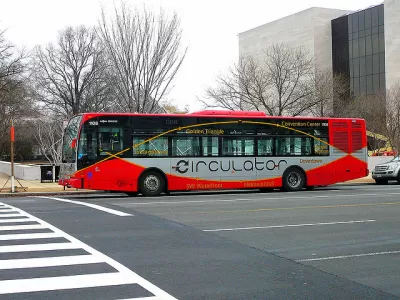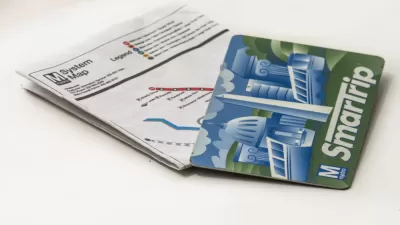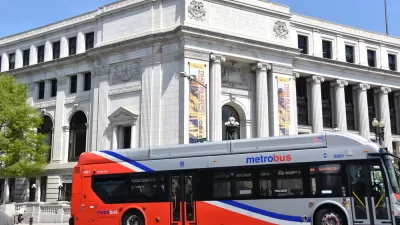The D.C. Circulator is struggling with maintenance costs and system performance. The balkanization of local bus systems in the region might be to blame.

Dan Malouf explains the effects of the balkanization, or fragmentation, of bus systems in the Washington, D.C. region.
So, there are "more than 20 separate bus providers in the Washington area. WMATA is the largest and covers the most territory, but most counties and large cities have their own," according to Malouf. "DC has Circulator, Montgomery has Ride On, Arlington has ART, etceteras."
It's the financial woes of the D.C. Circulator, reported by Martin Di Caro in May, that inspires Malouf's explanation. In fact, writes Malouf, the "situation suggests some of the thinking behind balkanization of the Washington region's bus network may be faulty."
The bulk of Malouf's analysis drills down on the inadequacies of how local bus operators measure the costs of operation. While the WMATA's Metrobus costs $142 per hour to operate, Fairfax County Connector runs at $104 an hour, ART runs at $72 an hour, and the DC Circulator runs at $83 an hour. However, as Malouf notes in detail, if the math looks too good to be true, it probably is.
FULL STORY: DC Circulator woes show why local buses can’t always replace Metrobus

Planetizen Federal Action Tracker
A weekly monitor of how Trump’s orders and actions are impacting planners and planning in America.

San Francisco's School District Spent $105M To Build Affordable Housing for Teachers — And That's Just the Beginning
SFUSD joins a growing list of school districts using their land holdings to address housing affordability challenges faced by their own employees.

The Tiny, Adorable $7,000 Car Turning Japan Onto EVs
The single seat Mibot charges from a regular plug as quickly as an iPad, and is about half the price of an average EV.

Seattle's Plan for Adopting Driverless Cars
Equity, safety, accessibility and affordability are front of mind as the city prepares for robotaxis and other autonomous vehicles.

As Trump Phases Out FEMA, Is It Time to Flee the Floodplains?
With less federal funding available for disaster relief efforts, the need to relocate at-risk communities is more urgent than ever.

With Protected Lanes, 460% More People Commute by Bike
For those needing more ammo, more data proving what we already knew is here.
Urban Design for Planners 1: Software Tools
This six-course series explores essential urban design concepts using open source software and equips planners with the tools they need to participate fully in the urban design process.
Planning for Universal Design
Learn the tools for implementing Universal Design in planning regulations.
Smith Gee Studio
City of Charlotte
City of Camden Redevelopment Agency
City of Astoria
Transportation Research & Education Center (TREC) at Portland State University
US High Speed Rail Association
City of Camden Redevelopment Agency
Municipality of Princeton (NJ)





























